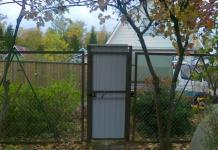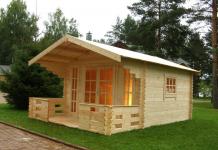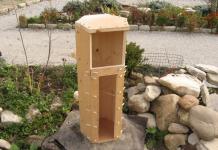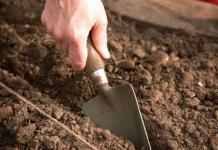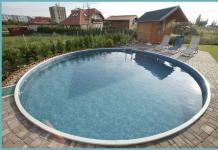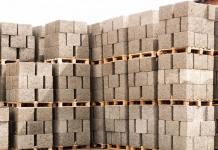Before the start of the winter season, one of the most important things is the preparation and storage of firewood. Not everyone will dare to donate a barn for them. This building is traditionally reserved for keeping domestic animals.
The only cost-free and simple way to store firewood in the country is a woodpile. In it, the fuel dries well and is available for use at any time. Little is required from the owner of the site - to fold the logs so that the multi-row structure does not collapse and does not spoil the appearance of the site.
Today we will talk about the various ways of laying firewood in detail and in detail.
Options for laying firewood on a plot in a woodpile
The general rule for storing any solid fuel is dry top and bottom. Therefore, the woodpile is raised above the soil surface, and its upper row is covered with a material impervious to atmospheric moisture.
All existing methods of laying firewood are aimed at achieving the stability of the woodpile. You can’t just take and fold the round timber trimmings on top of each other. Therefore, not chopped firewood is most often stored together with chopped wood. They do not allow the array to crumble. We see a variant of such styling in the photo below.

Round timber in the middle, chipped chocks on the edges - compact and stable
If we talk about the most common storage methods, then three options should be mentioned:
- Stack (firewood in rows are stacked parallel to each other).
- "Crate" (each top layer of firewood is laid perpendicular to the bottom).
- Circular method (chocks are folded into an annular woodpile).
Stacking is not very stable. Therefore, this method requires the presence of a supporting wall. Any building (bath, barn, garage, house) can play its role.

A stack resting on a barn wall is the easiest way to store firewood.
When laying firewood in parallel rows, you need to create a slight slope towards the supporting wall to increase the stability of the masonry. The easiest way is to sort the firewood so that the thicker ends are on the outside. Another option is to lay long wooden slats under the outer ends of the logs, which create a slope.
If the stack in the yard needs to be made freestanding, then a wooden semi-frame made of boards is used to protect the firewood from spilling.

The semi-frame of a single-row woodpile will not allow the logs to crumble

A wood stand is more stable than a stack because it provides better grip. For this method of storage, long chocks are usually used.
It must be said that stacking firewood in a woodpile is not a routine process, but a creative one. Many summer residents create picturesque structures from wooden chocks that decorate the site.

A little imagination and a bunch of firewood turns into a funny lumberjack


Round woodpile in the form of a house with a roof
Not chopped logs - original decorative material, ideal for landscape design.

Woodpile in the form of an arch - decoration of a summer cottage recreation area
By placing firewood in a closed “hut” type structure, you will receive high-quality dried fuel and create a beautiful installation for a barbecue area.

For some, a woodpile is just a pile of wooden chocks. In a person with fantasy, it turns into a fallen tree with yellow leaves.

This amazing picture-panel is created from ordinary firewood.
You can paint with paints and a brush on canvas, or you can create a picturesque “canvas” using chopped firewood of different thicknesses.

A real artist needs only two cubic meters of fuel to express himself
Stacking firewood in a circle forms a stable woodpile and opens up good prospects for decorating it.

Animated firewood smiles at its owner
Some lovers of wood-burning architecture create interesting woodpile designs that resemble a dome or a haystack.

Wood dome with a "cap" of logs for water drainage
How to fold a woodpile with your own hands?
Stacking firewood neatly in a stack is easy. The main attention should be paid to the evenness of the site and the first "starting" row. A more interesting and complex option is a round woodpile. We will consider the process of its formation step by step:
The first stage is leveling the site and drawing a circle along which the logs will be folded. You can make it with a stake driven into the ground and a rope tied to it. Having attached a sharp chip or piece of reinforcement to its end, a circle is drawn on the ground.
The first circle of logs is folded in the form of a chain so that they are in contact with the ends.

The second round of firewood is placed in a direction perpendicular to the first. This creates the slope necessary for the stability of the woodpile.

You can fold a round woodpile in one row, but then it will have a lot of empty space inside, and the stack will be unstable. Therefore, simultaneously with the outer circle, they are laying the inner one.

The general principle of warehousing does not change. The inner circle should also have a slope inside the woodpile. To do this, thin wooden dies are placed under the ends of the firewood. Due to the slope, the woodpile gradually narrows upward and takes the form of a haystack.
In the middle of the woodpile, firewood can be stacked in any order, filling the resulting void.

Having increased the "wood stack" to a height of 1.5 meters, you can begin to form the top. For this, the logs are stacked in a slide, observing the slope from the center to the edge.


The optimal dimensions of a round woodpile: height 2 meters with a diameter of 3 meters.

In this form, the woodpile can be left for the whole winter, taking fuel out of it as needed. To better protect the firewood from getting wet from above, we recommend hoisting a “cap” of straw or laying several pieces of roofing felt.

Many gardeners have stumps left after cutting down old trees. And the owners of the plots have a choice either to uproot and eliminate, or somehow build the stumps into the design and continue their useful existence.
There are not many recipes for the latter. The easiest way is to use the stump as a stand or pendant for flower pots. But let's look at a more interesting option, converting the stump itself into a large pot - a flower bed, i.e. we will try to turn the stump into a deck, fill it with soil in which we will then plant flowers. As a result, we should get something like this.
 1. We find out the state of the stump.
1. We find out the state of the stump.
It makes sense to make a flower bed only from wood that is not infected with pests. In some places, it will even rot, and even have a hollow, this is not scary, but it will even make the job easier. If bark beetles and other beetles have chosen the stump, it is better to eliminate it so as not to make a hotbed of future problems in the garden.
2. We determine the size of the future flower bed and its configuration.
The simplest thing is to measure 5 cm from the edge on the saw cut and draw a line through these points - this will be the border of our pot.
3. Choose a method for removing the center of the stump.
But before this, the first thing we remember about safety precautions is to put on gloves goggles - there will be chips in any way of working!
So, you can choose the center of the stump in different ways:

- If a benzo or electric saw is available you can saw through the center and then work with a chisel to cut out the squares
- You can build a small fire in the center of the stump and burn out its center in this way.
- There is an option with "chemistry"- for this, we drill holes in the center of the stump and pour Epsom salt there (we buy it in pharmacies) or saltpeter and wait a few weeks.

After such an “attack”, the wood will quickly collapse and all that remains is to clean up the edges of the “funnel”.
- But we will go in the old grandfather's mechanical way.
- We take a pointed hoe and, moving in a circle, cut a hole in the center of the stump with its sharp end.

When the hole in the stump is larger, turn the hoe around and chop with the wide side.

Thus, we are moving towards the outlined line of the “pot” border. It is necessary to deepen the hole in the stump by 10-20 cm, depending on its diameter and the plants that are going to be planted there.
When you finish with the recess, consider that the flower bed is almost ready. Let's move on to the final steps.
4. We make drainage.
So that the water in the stump does not stagnate, it is necessary to take care of its removal.

Using a drill with a diameter of at least 1.5 cm, we make several inclined holes from the center of the flower bed to the ground surrounding the stump.
Further, drainage from pebbles can be poured to the bottom of the flower bed, then the water will leave more easily.
5. Fill the stump with earth and plant the plants.
On top of the drainage, we pour nutrient soil more suitable for the flowers you have chosen and plant them. A mixture of 1 part compost and two soil has proven itself well.
Everything, it remains for us to water and photograph the result of the work.

In conclusion, a few tips and tricks for making a flower bed from a stump:
- To make it easier for yourself to extract wood from the center of the stump, use a drill and a large drill bit. Frequent holes around the perimeter of the hole and in the center will significantly reduce the time of work and the cost of effort for chiselling.
- If you burn the center of the stump, you can use kerosene (not gasoline!!!) to saturate the wood, after which it will burn better.
 - Almost any plant can be planted in a stump, but of course blooming ones look more beautiful like: marigolds, geraniums, begonias. Look great in such natural pots, pansies, primroses and forget-me-nots. Daffodils, tulips and purslane grow well in stumps. Ampelous nasturtium and petunia look especially impressive in the stump. You can do any height, both undersized and high landings.
- Almost any plant can be planted in a stump, but of course blooming ones look more beautiful like: marigolds, geraniums, begonias. Look great in such natural pots, pansies, primroses and forget-me-nots. Daffodils, tulips and purslane grow well in stumps. Ampelous nasturtium and petunia look especially impressive in the stump. You can do any height, both undersized and high landings.
- You can extend the service life and facilitate the care of the stump flower bed with the help of plastic pots. The manufacturing technology will not change, except that the recess in the stump must be adjusted to the size of the pot or tray.
- And in the end, a very simple option with a portable stump - a blende. To do this, we cut down the stump above the ground itself and carry the saw cut to process it in the workshop, where, using a saw and all available tools, we make a large hole suitable for a pot, which we insert there. Then we return the stump to its native place - to the cut. Thus, it is possible to greatly facilitate the work on wood and the subsequent operation and maintenance of the flower bed.
Properly and beautifully stacked firewood is the key to a hot fire. In an ideal woodpile, they will not get wet, they will not disappear, they will not lose their hot properties.
Dry firewood . If raw firewood is stacked, it will dry out in the woodpile, and the combustion efficiency of such firewood will become an order of magnitude higher.
Kindling is less of a problem. Dry firewood ignites easily and simply in a stove or fireplace.
Is it possible to stack raw firewood? It is possible, but when drying, slender stacks can warp. And a beautiful woodpile - to collapse.
We save usable space. Compact placement of firewood on the site will allow you to collect a fairly decent amount of them, while the chaotic method will be quite voluminous in appearance, but small in terms of the amount of stacked firewood. If you need to save a large amount of firewood, only the woodpile will help out.
aesthetic moment. Plus - beautiful wood-burning walls and woodpile - a real decoration of the site, a full-fledged element of the landscape design of the cottage, village, country house.
In other words, stacking firewood correctly and beautifully is worth it. We will get not only aesthetic pleasure at the sight of neatly stacked firewood in the end - but also a lot of advantages during the heating season.
Parallel way of stacking firewood - stacked
The essence is simple - you can lay each new layer parallel to the previous one.
In this case, the wall of firewood should touch the previous wall. those. laying firewood in the second wall, push it all the way - with its inner end it should touch the previous wall.
Each wall is laid with a slight slope inward. This bias is achieved by selecting uneven firewood.
Outward slope is unacceptable, even slight. With the acquisition of height, the external skew will intensify and the entire wall will collapse.
We do not bring each wall to the top until we adjust the next one. For sustainability. i.e. simultaneously lay out several walls with steps.
It turns out very economically and clearly, a large amount of firewood can fit on a relatively small piece of land.
Perpendicular method - cage
Firewood is laid perpendicular to the previous row.
If you plan to stack firewood in this way - it is desirable to cut them more authentically. Even firewood, of course, is easier to stack.
circular way
Firewood folded in a circle dries perfectly. Especially if you leave a ventilation column of empty space inside the stack.
Ideally, stacked firewood does not flow, but it is not easy to achieve such a density of the top layer of firewood - therefore, novice craftsmen usually cover the firewood with additional waterproof material.
We offer photos of beautiful woodpile! From the photo you can easily understand how the firewood was stacked. Difficulties usually do not arise.















To dry firewood for the winter, it is necessary to have a certain place for this in the form of a barn or, in extreme cases, a canopy. However, not everyone has the opportunity to equip such a repository on their territory. An alternative solution is self-formation woodpile.
In addition to the drying function of firewood, it can become an element of decor in the garden: the woodpile needs to be beautifully decorated.

We advise you to store firewood behind the house near the garden path. This will be most convenient when the weather is inclement, and you do not have to walk through the mud through the entire garden. In addition, the woodpile can also serve as the basis for the table of the barbecue area.
To arrange the laying of an ordinary woodpile on your own, you need to have tools in your arsenal:
- hammer and screwdriver;
- joiner's clamp;
- circular saw;
- tape measure and screws for woodworking.

In addition, you will need materials for the frame:
- 2 boards of 3 meters each, not less than 3 cm in thickness and up to 15 cm in width for the base;
- 4 boards of 1.5 m for the side parts;
- a board of 1 m in thickness of 3 cm and a width of up to 15 cm.

We prepare the site
First, we determine the location of the woodpile. We advise you to put it on a concrete base or on a laid out brick surface. Thus, the boards will not rot. After preparing the base, the frame is created.

We fold the frame
A board of 1 meter must be cut into 4 elements of 25 cm each. They will be needed for the transverse sides of the frame. When the logs are less than 25 cm long, the boards will need to be cut to make the material to be laid longer. Next, we assemble the frame. You can see the details of the styling technology in the video tutorial.
After assembling the frame, we begin laying the woodpile.

DIY woodpile photo
Laying methods
The strength of the woodpile and its service life depend on the laying of firewood in the frame.
Recommendation! Stack the wood tightly so that the bottom is the most even and long logs. The maximum height of the structure should be up to 1 meter 50 cm with a slide. During laying, it is necessary to take into account the stability of the woodpile. So that the frame does not deform, it is better to remove excess material.
It is worth noting that due to loose stacking, the woodpile may collapse, as the firewood dries out and gaps appear between them.
A simple do-it-yourself woodpile, video
However, this design also has some disadvantages: there is no protection from snow and rain. An alternative may be slate sheets that are laid on top of the structure. Lay the wood in advance with a slight slope so that water can flow down the slate. A slate sheet 113 cm wide, it is either cut in two, or logs are laid in two or three rows.

We equip a round woodpile
For this type of woodpile, you need to expend more effort, but round styling looks the most attractive.

How to fold a round stack of firewood
To carry out the process yourself, you will need:
- polyethylene film;
- rope and tape measure;
- marker and nail.

We prepare the basis
First you need to clean the surface of the earth from debris and prepare an even layer. Then a film of polyethylene is placed on top of the ground to protect the firewood from rotting. To make the woodpile look aesthetically pleasing in the form of a circle, the edges of the film are cut off. This is done with a nail, which must be driven into the center of the film, and a rope. We take the end of the rope with a marker and, pulling it, draw a circle. So the base is rounded.

Logs require even stacking in the form of a circle so that they do not go beyond the boundaries of the film. Pay special attention to the first layer, lay it out as carefully as possible. The curved layer will surely make itself felt: the design will turn out to be unstable and ugly.
Oval woodpile, video
After laying the bottom layer, we repeat the process up to 50 cm. The height of the structure. Now we fill in the gaps so that the logs fit evenly inside. We turn again to laying the outer rings to the required height of the woodpile (as a rule, it is 1.5 meters). The end of laying - the design of the roof. The inner logs should be slightly higher than the outer logs. We lay the planks on top in the form of tiles.

One of the types of paving with paving stones is paving in a circle. This technology is fundamentally no different from the traditional methods of laying tiles and paving stones, but still has its own nuances. Paving stones or paving slabs have long been the most popular pavement for paths near a house or cottage. Such paths in the garden look very beautiful, especially since they can be made in various colors. A properly made paving stone path will serve for a very long time without losing hardness, color and attractiveness.
Path paving: trench and concrete base pouring
It must be said right away that the preparation of the foundation for the future path is always carried out in the same way, and does not depend in any way on how the tiles will then be laid out.
Try to take into account all the specific features of the soil, its moisture content and other factors.
Visually level the area or path and dig into the ground throughout the area to provide yourself with a place to pour concrete. It is necessary to dig into chernozem soils by 15-25 centimeters, if the soil is hard, you can dig less deeply.
It is necessary to begin direct preparation for paving from the compaction of the subgrade to a solid, stable state. Depending on the composition of the soil, it is sometimes possible to do without a concrete pad (in the case of sandy soil), if the path is only pedestrian, but in this case it is better to tamp the ground or roll it very well.
For walkways and the area in front of the garage, two different technologies can be applied, the most suitable for each case.
1. For the paths, the next step will be the laying of storm drains (storm sewer pipes) and curbs, which we will install on the sides.

2. In the resulting hole, we fall asleep a ten-centimeter layer of medium-sized gravel. It is a base for tiles and at the same time excellent drainage.

3. From above we pour another five centimeters of sand mixed with cement in a ratio of five to one. This is the underlayment layer. A mixture of sand and cement, which is used to fill the last layer before the tile, is often called gartsovka. A concrete slab, if you decide to do one, you need to fill up with a layer of up to three centimeters.

4. We carry out one more tamping, designed to identify weak points that need to be poured right there.


The platform is a little different.
1. So, having carefully leveled the resulting recess, I fill its bottom with a small layer of sand.

2. Then we fill in a twenty-centimeter slab of concrete, and even reinforced, because a car will constantly drive here.

3. It is important to remember that it will be much more accurate if the storm drains and curbs are not poured here in advance, but are fitted as soon as the concrete begins to harden. And the basis is there, and everything turns out cleanly.

It is necessary to plan any path or site so that the slope towards the storm drain is at least three percent, and the more relief the planned coverage, the greater it is better to make the slope. Otherwise, there is no guarantee that there will not be a large puddle at the site.
Paving with paving stones in a circle
Paving with paving stones or paving slabs will not be difficult for anyone, but "straight" masonry looks boring. Much more fun when the path is lined with figures, circles, for example.

However, paving paths in a circle has its own nuances.
- To beautifully lay out circles and other “smooth” figures, you need an area, and a much larger one, near the path.
- You can lay out only parts of the circles, alternately adjoining opposite sides of the track, and lay the paving stones between them in a direct way. It looks cute and original.
- Do not be afraid to trim the tiles - there are trimmings, but there are no more of them than with normal installation.
As for technology, everything is simple here:
1. We make the right size compass from improvised means.

2. We draw a circle with it directly on the sand prepared for laying (do not be alarmed if you guess with the size only the third time).


In the same way, you can perform any other shapes - we measure, draw and lay out inside. Only with circles you can come up with a bunch of patterns, ornaments and color combinations. You can make an ornament with multi-colored rings or even waves placed one inside the other - it will come out fun and spectacular.

4. After all the stones are in place, they need to be covered with sand thickly so that all the seams are clogged. Then all this is sprinkled abundantly with water, the cement in the substrate “grabs” and the path / platform is ready.

Paving paths and playgrounds in a circle is a creative process that requires accuracy and developed spatial thinking, however, using this technology, you can create very interesting effects, “revitalizing” the landscape of your site.






